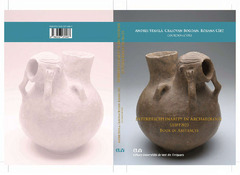Приказ основних података о документу
An initial insight into the early Lower Paleolithic of the Central Balkans investigations of Petrovac 1 site on the Radan Mountain in southern Serbia
| dc.creator | Mihailović, Dušan | |
| dc.creator | Mladenović, Stefan | |
| dc.creator | Plavšić Gogić, Senka | |
| dc.creator | Dragosavac, Sofija | |
| dc.creator | Petrović, Anđa | |
| dc.creator | Marković, Jelena | |
| dc.creator | Miladinović, Zoran | |
| dc.creator | Roksandić, Mirjana | |
| dc.date.accessioned | 2023-11-29T21:56:55Z | |
| dc.date.available | 2023-11-29T21:56:55Z | |
| dc.date.issued | 2023 | |
| dc.identifier.isbn | 978-630-327-048-7 | |
| dc.identifier.uri | http://reff.f.bg.ac.rs/handle/123456789/5520 | |
| dc.description.abstract | Based on the premise that Lower Paleolithic sites in the Central Balkans can be expected in the vicinity of primary and secondary deposits of raw materials, intensive explorations have been carried out in the last decade in the area of the spread of the Vardar geotectonic zone with pronounced Miocene volcanism and rich opal and chalcedony deposits formed under hydrothermal conditions. At the largest of these deposits - in the area of the Radan Mountain - we identified a large number of lithic scatters with numerous artifacts from the Lower Paleolithic. At one of them - at the location of Petrovac 1 - test excavations showed that there are at least two layers with Paleolithic artifacts. The deepest layer (3) contained unipolar, bipolar and irregular cores, very small, often elongated flakes, and a small number of slightly modified tools on flakes, as well as massive chopper-like tools made from fragments of pyroclastic rocks. The upper layer (2) contained an industry characterized by SSDA, centripetal and preferential cores, but without elaborate Levallois products. Although attempts at radiometric dating have not been successful so far, the assemblage from the layer 3 can be attributed to the core and flake (Mode 1) industries that occurred in the Balkans from more than a million years ago (Kozarnika) until 500-300 thousand years ago (Marathousa, Dealul Guran). The findings from layer 2 do not have close parallels with other sites in the Balkans, since so far only a few Chibanian (previously Middle Pleistocene) sites with the small tool assemblages have been identified. The Radan site has a great potential for studying the development of Lower Paleolithic technology in this part of Europe. | sr |
| dc.language.iso | en | sr |
| dc.publisher | Editura Universitatii de Vest din Timisoara | sr |
| dc.relation | info:eu-repo/grantAgreement/ScienceFundRS/Ideje/7746827/RS// | sr |
| dc.rights | openAccess | sr |
| dc.rights.uri | https://creativecommons.org/licenses/by/4.0/ | |
| dc.source | Interdisciplinarity in Archaeology UISPP 2023 Book of Abstracts | sr |
| dc.subject | Lower Paleolithic | sr |
| dc.subject | Balkans | sr |
| dc.subject | Radan | sr |
| dc.subject | core and flake industries | sr |
| dc.title | An initial insight into the early Lower Paleolithic of the Central Balkans investigations of Petrovac 1 site on the Radan Mountain in southern Serbia | sr |
| dc.type | conferenceObject | sr |
| dc.rights.license | BY | sr |
| dc.citation.spage | 186 | |
| dc.identifier.fulltext | http://reff.f.bg.ac.rs/bitstream/id/14014/bitstream_14014.pdf | |
| dc.identifier.rcub | https://hdl.handle.net/21.15107/rcub_reff_5520 | |
| dc.type.version | publishedVersion | sr |

